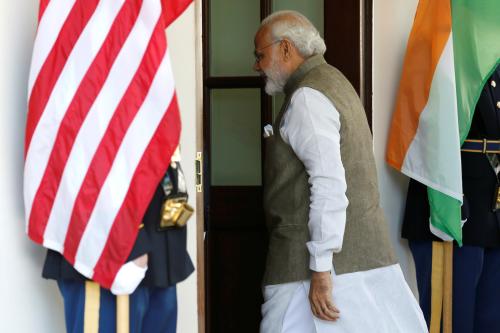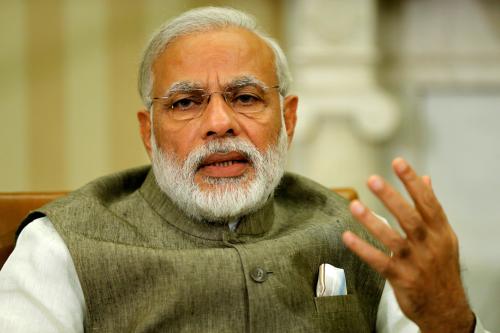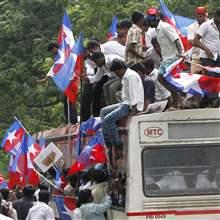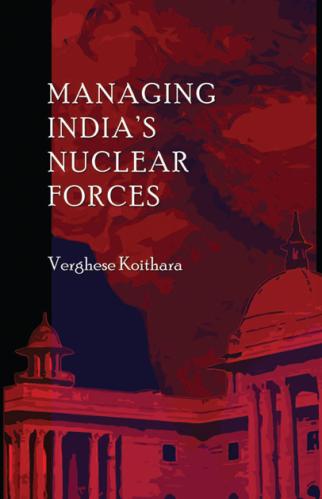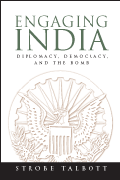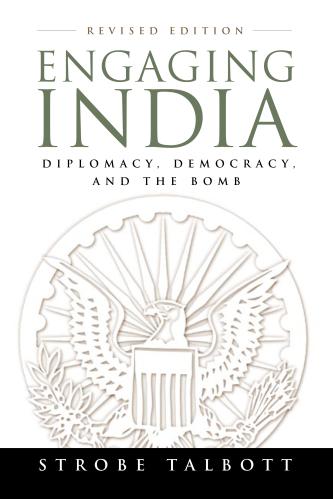Content from the Brookings Institution India Center is now archived. After seven years of an impactful partnership, as of September 11, 2020, Brookings India is now the Centre for Social and Economic Progress, an independent public policy institution based in India.
This memo is part of the Brookings India publication, India-U.S. Relations in Transition. The views are those of the author(s). Brookings India does not hold any institutional views.
India and the United States have come a long way since 2008, the year that Barack Obama was elected U.S. President.
Earlier that same year, Indian Prime Minister Manmohan Singh took the unusual step of putting the future of his government on the line over a matter of foreign policy – specifically, a civilian nuclear agreement with the United States. Dr. Singh barely survived a vote of no confidence in the Lok Sabha, India’s lower house of parliament. History might have proceeded very differently had he failed.
The years between 1998 and 2008 had been heady ones for India-U.S. relations. Following a brief period of U.S.-led sanctions following India’s 1998 nuclear tests, the two sides made efforts to turn a new page in their relationship. Indian Prime Minister Atal Bihari Vajpayee was swift in trying to assuage some of Washington’s concerns and described the two countries as “natural allies.” An intense period of negotiations on India’s nuclear status culminated in the historic visit of U.S. President Bill Clinton to India in 2000. Meanwhile, American concerns over Y2K – the Millennium bug – gave a boost to India’s nascent software industry, helping it to evolve into a global presence. The two countries were soon talking about collaboration on ballistic missile defence (BMD) and India went so far as to seriously contemplate sending troops to Iraq in 2003 to support the U.S.-led state-building efforts in that country. In 2005, the two countries signed a ten year defence framework agreement, and laid out the terms for a civilian nuclear agreement that would bring India into the global nuclear mainstream. Philip Zelikow, then Counselor at the U.S. State Department, said blandly that the United States’ “goal is to help India become a major world power in the 21st century…We understand fully the implications, including military implications, of that statement.” Two years later, India and the United States – along with Australia, Japan, and Singapore – held large-scale multilateral naval exercises in the Bay of Bengal.
Initially, the post-2008 era looked likely to belie some of the more enthusiastic predictions that resulted from these developments. Just months before Barack Obama’s election, the United States experienced a financial crisis that had severely negative repercussions for its economy and affected its global credibility. In the aftermath, Washington made attempts at reaching an accommodation with a more confident China on Asian and global issues, much to India’s chagrin. U.S. counterterrorism imperatives in Afghanistan and Pakistan also defined the new administration’s approach to India’s neighbourhood, side-lining some of New Delhi’s concerns.
It was not just the United States that was economically weakened and distracted. After an initial resurgence following the Global Financial Crisis, India’s economy too began to slow, with growth tumbling between 2010 and 2012. Fiscal profligacy, bad loans, corruption scandals, and policy fluctuations deterred investment, and India adopted a more cautious approach in many of its foreign dealings, including with the United States. The low point arguably came in late 2013, when the detention of an Indian deputy consul general in New York by U.S. authorities resulted in a nasty public spat between the two governments. The incident, and its handling, was perhaps more of a symptom than a cause of the poor state of relations.
The last two years have seen a gradual upswing, with particularly important strides on the security dimensions of the relationship. For Washington, the partnership with India is now an integral element of the U.S. rebalance to Asia. For New Delhi, the U.S. is a major source of technical, technological, and financial support to assist in India’s domestic transformation. India is also less shy about considering opportunities to enhance the strategic partnership. Consultations and cooperation in Asia have improved, corresponding to a clearer alignment of interests, although differences remain on many issues in South Asia and the Middle East. Yet for all the progress, the relationship still requires continuous tending in order to overcome hurdles and manage divergences. This will be particularly important as India, the United States, and the world experience important political, economic, social, and technological transitions over the coming years.
NOTE: Hover your mouse on these interactive graphs for detailed figures
Data compiled by Neha Aggarwal, Dhruva Jaishankar, Shruti Godbole, and Aditya Sharma. Sources: U.S. Department of Commerce, U.S. Energy Information Administration, Indian Space Research Organisation, Ministry of Commerce and Industry (India), Ministry of Tourism (India), Mint, Petersen Institute for International Economics, Stockholm International Peace Research Institute, The Wall Street Journal, and Zinnov.
Notes: ‘Present’ data is from 2015, except R&D centres (2013); Indian goods exports, Indian FDI to US, Indian student, and U.S. tourist data (2014); and Indian satellite launch data, which includes planned launches for 2016-2017. Figures for U.S. defence exports are in 1990 U.S. dollars.
Related Articles: A Crash Course in India-US Ties as Modi Prepares for Washington which appeared in Quint on 07th June 2016; The US and India: A Complex “Partnership” which got aired on KCRW on 8th June 2016

